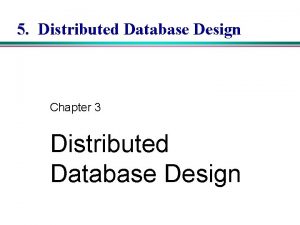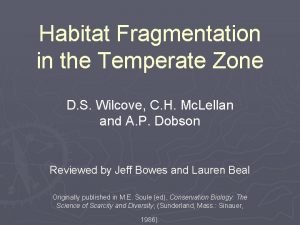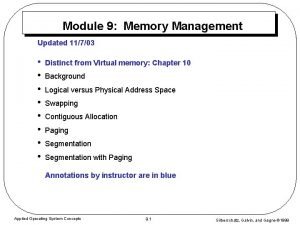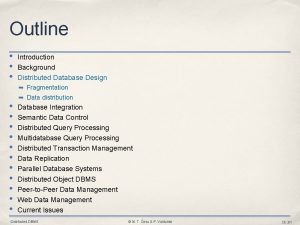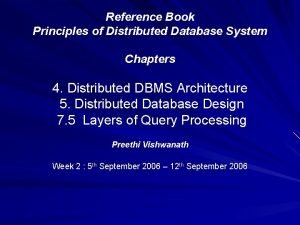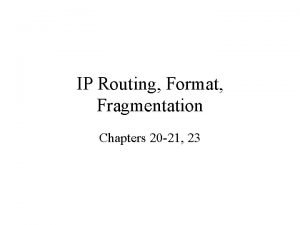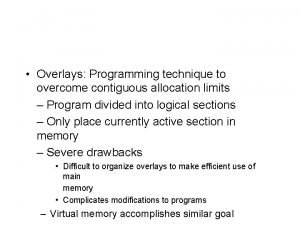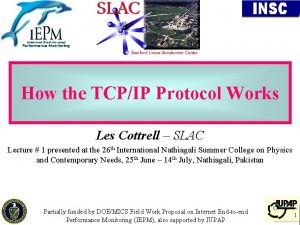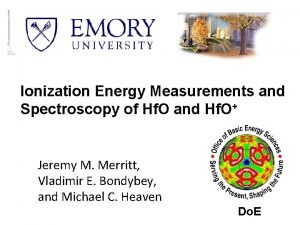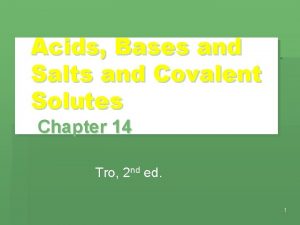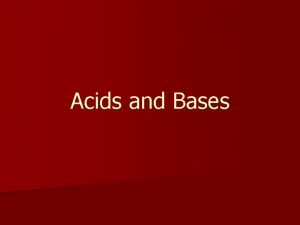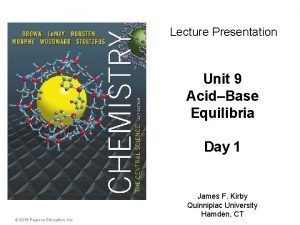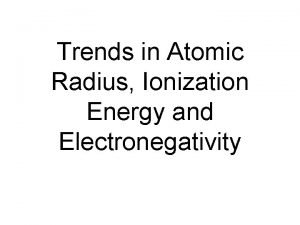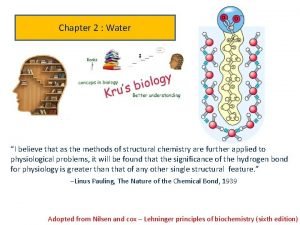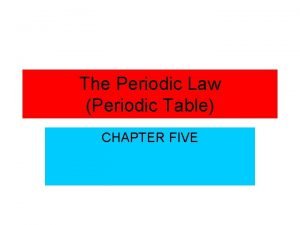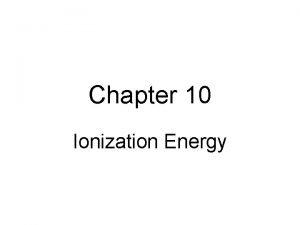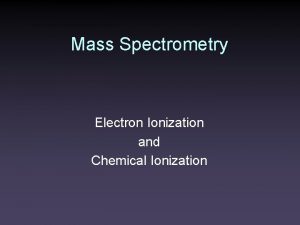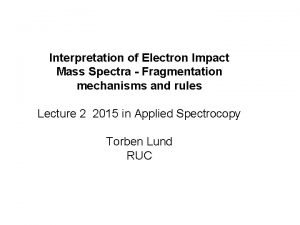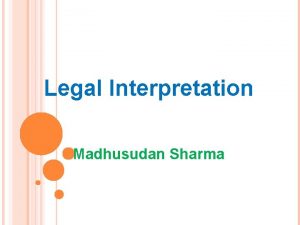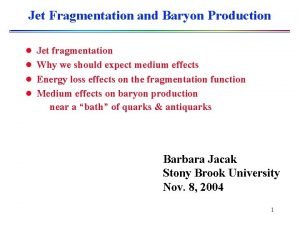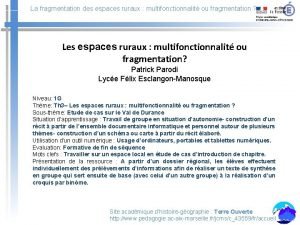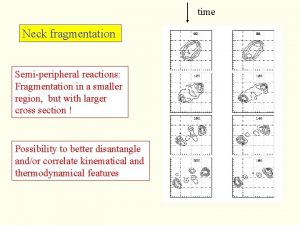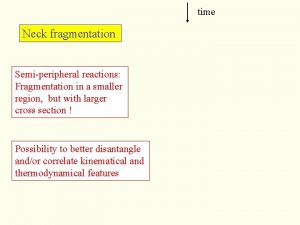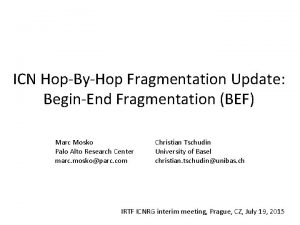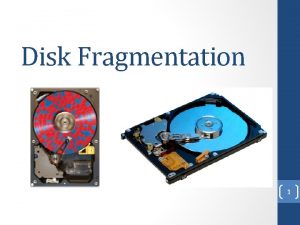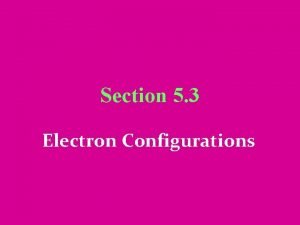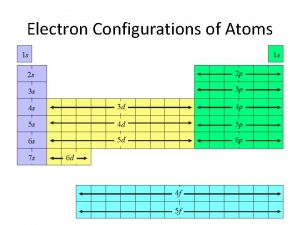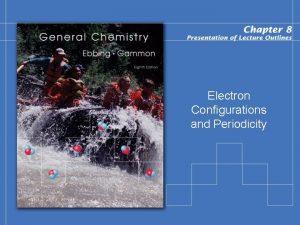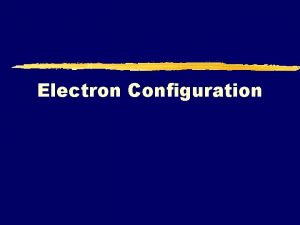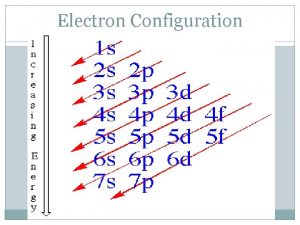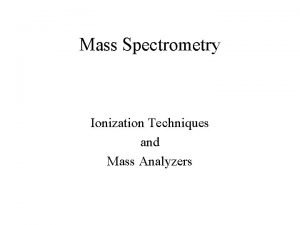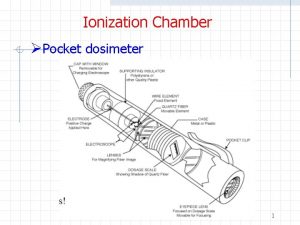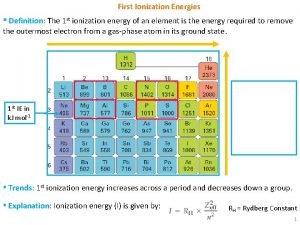MS Interpretation II Fragmentation Ionization OE Electron Ionization
































- Slides: 32

MS Interpretation II Fragmentation

Ionization OE+ • Electron Ionization (EI): Even-electron neutrals yield odd-electron radical cations. M(EE) EI - 1 e- M + • (OE) Electron can come from anywhere. EI EI - 1 e- (n) even electron - 1 e- (π) odd electron even electron EI - 1 e- (σ) even electron odd electron

Ionization OE+ • Electron can (and does) come from anywhere. - 1 e- (n) EI EI EI - 1 e- (π) - 1 e- (σ) vacuum level Likelihood of each of these depends on energy levels in molecular orbitals: σ* π* n π σ IEn most likely IEπ IEσ least likely

Ionization OE+ • Electron can (and does) come from anywhere. - 1 e- (n) EI EI - 1 e- (π) EI Naturally, cannot distinguish these in mass spectrometer (all have m/z = 100). But fragmentation patterns will be different. - 1 e- (σ)

Ionization EE+ CI, MALDI and ESI: Even-electron neutrals yield even-electron cations. M(EE) + H+ MH+(EE) Like EI, ionization may occur at multiple places. + H+ + + Again, instrument cannot distinguish.

Fragmentation Mechanisms: EE+ • EE+ ions don't fragment to form OE+ • • Fragmentations more familiar and spectra generally less complex than OE+ • • More frequent and varied rearrangements can make interpretation more difficult • Spectra can be more sensitive than EI to small structural changes • Sensitivity to experimental conditions incompatible with reference libraries

Fragmentation Mechanisms: EE+ • Bond cleavage with charge migration – R-OH 2+ → R+ + H 2 O • Cleavage with cyclization and migration – • Two-bond cleavage with charge retention – • Other fragmentations require MS/MS

Fragmentation Mechanisms in MS: OE+ • Electron Ionization: Fragmentation is always unimolecular. Two possible categories of fragmentation: parents M M daughters • (OE) B + + • A+(EE) + • A+ • (OE) + B(EE) (OE) charge migration (radical and charge part ways) charge retention (neutral molecule is ejected) Important: Only daughter ions are detected by MS instrument. Released neutrals are only inferred.

Fragmentation Mechanisms: OE • + • Direct dissociation – R-R' → R+ + R' • • Cleavage adjacent to a heteroatom – R-CH 2 -Y-R' → R-CH 2+ + • Y-R' – R-CH 2 -Y-R' → R-CH 2 • + +Y-R' • α-Cleavage – R-CH 2 -Y-R' → R • + CH 2=Y-R'+ – R-CH 2 -Y-R' → R+ + • CH 2 -Y-R' • Two-bond cleavage – Retro Diels-Alder • Rearrangement – Mc. Lafferty Rearrangement

Fragmentation Mechanisms in MS: Direct Cleavage EI (electron can come from any bond) + + Fragmentation (one-electron bond can break either way) + + + 15 43 57 + 71 + + 43 + 29 + 15

Relative Abundance Fragmentation Mechanisms in MS m/z + + + 15 43 57 71 + + 71 + 43 + 29 + 15

Fragmentation Mechanisms in MS What governs which ions are predominant? 1. Most ionizeable type of electrons. Here, all electron sources are σ bonds. 2. Combination of most stable cation and radical. (Actually, this addresses most ionizeable bond within type. ) Here, secondary cation/radical combination favored over primary. 3. In charge separation, cation stability is more important than radical stability. Here, masses 71, 43 favored over 15, 57. + + + 15 43 57 71 + + 71 + 43 + 29 + 15

Relative Abundance Fragmentation Mechanisms in MS m/z + + + 43 15 57 71 + + 71 + 43 + 29 + 15

Fragmentation Mechanisms in MS: Direct Cleavage + + 57 + + 71 + + 43 Further fragmentation is common.

Fragmentation Mechanisms in MS: α-Cleavage 56 + + 41 +

Heteroatoms: Induced vs. Alpha Cleavage t-butyl ether 57 87 59 87 57 59 102

2 -butyl ether i 57 α 73 45 45 73 59 57 87 102

Competition: i vs α Cleavage • Induced cleavage is favored for larger heteroatoms • α-cleavage is favored for electron donating substituents • Br, Cl < R • , π bond, S, O < N

butanethiol 47 57 41 57 90 47 Both α- and icleavage are observed here

butylamine 30 30 α-cleavage dominates spectrum here 73

OE+ • Fragments • Odd electron fragments are less common, especially at low mass – Even mass ions at low mass likely contain N • These fragments arise from two-bond cleavages, or rearrangements • Even mass OE+ • fragments are important ions, as they can be highly sensitive to structural changes

2 -hexanone 43 43 58 58 71 85 100 OE+ • Product is from Mc. Lafferty rearrangement

2 -methyl 3 -pentanone 71 57 57 43 Mc. Lafferty rearrangement is precluded here 29 100 71 85 No major OE+ •

104 Charge stays with styrene fragment in this case 158

130 158 130 143 Charge stays with phenylbutadiene

177 135 149 159 192 Match the spectrum to the structure 121 93 136 109 192 177

136 121 93 136 Retro Diels-Alder reaction is observed 109 177 192

X Retro Diels-Alder reaction is not observed 164 177 135 149 159 192 Aromatization via substitution dominates the spectrum

105 Match the Structure to the Spectrum 77 122 150 119 91 118 150 91 150

105 77 122

119 91

91 119 118
 How does interpretation b differ from interpretation a
How does interpretation b differ from interpretation a Minterm predicate
Minterm predicate Ip fragment
Ip fragment Invisibility bias
Invisibility bias Segmentation and paging
Segmentation and paging Dichotomy corollary
Dichotomy corollary Database system technology
Database system technology Process virtual address space
Process virtual address space Habitat fragmentation in the temperate zone
Habitat fragmentation in the temperate zone External fragmentation in os
External fragmentation in os Correctness of fragmentation
Correctness of fragmentation In contiguous memory allocation has no cure
In contiguous memory allocation has no cure Problem areas in ddbms
Problem areas in ddbms Index fragmentation
Index fragmentation Example of fragmentation in globalization
Example of fragmentation in globalization Fragmentation modernism
Fragmentation modernism Correctness rules of fragmentation
Correctness rules of fragmentation Distributed relational database design
Distributed relational database design Acculturation
Acculturation Ipv4 fragmentation
Ipv4 fragmentation A technique for overcoming internal fragmentation
A technique for overcoming internal fragmentation Ms nn
Ms nn Ip fragmentation
Ip fragmentation Example of budding
Example of budding Pulsed electric field
Pulsed electric field Ionization vs dissociation
Ionization vs dissociation Self ionization of water equation
Self ionization of water equation Strength education
Strength education Self ionisation of water
Self ionisation of water Ionization energy trend
Ionization energy trend Periodic table of elements atomic radius
Periodic table of elements atomic radius Protein ionization
Protein ionization Which element has the lowest ionization energy
Which element has the lowest ionization energy

